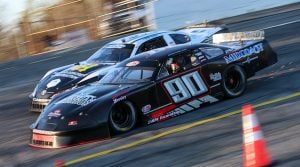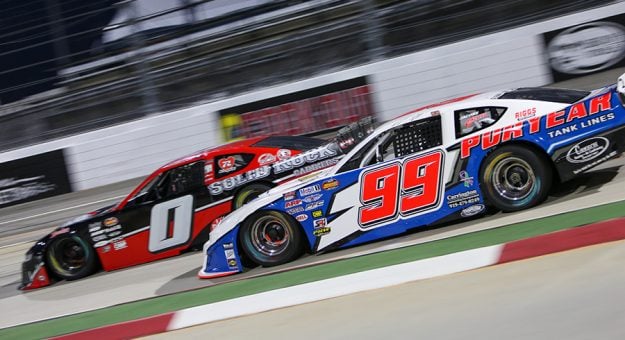Chassis & Setup
Just like the engines, the chassis for a super late model and a late model stock car are extremely different. Faulk laid out the differences by first explaining what a typical late model stock car chassis and setup looks like.
“The late model stock chassis are all perimeter chassis, which means most frame rails go out equally to the left and to the right,” Faulk said. “They’re made out of three-by-four tubing and they’re basically designed off of a stock-type car where you have equal chassis on both sides of the car.
“They weigh 3,100 pounds and have a single-piston brake caliber. They all have steering boxes versus a rack and pinion. You can have a three-link, but most people run a truck trailing arm, which is 51 inches long.
“The roll cage is supposed to be symmetrical from left to right, door bars out in the right door, the same as in the left door,” Faulk continued. “They have a roof height of I believe 47 inches minimum. They’re supposed to be a symmetrical chassis. Wheel locations, A-frame locations, basically to reassemble a square car kind of like a street car.”
The first major difference between late model stock cars and super late model chassis is that a super late model utilizes an offset chassis that favors the left side of the car. Most of the significant items within the car, such as the rear-end housing or the location of the engine, are offset to the left.
“Everything is offset in a super late model to the left,” Faulk said. “In other words, the rear-end housing is two to three inches offset. The suspension is two to three inches offset. The engine location is offset to the left.”
Many of the parts and pieces under the chassis are also massively different.

“The suspensions on super late models are what they call a three-link,” Faulk said. “It has two trailing arms on the bottom (plus a third link mounted on top of the rear differential), which is somewhere between 21 to 24 inches, versus a 51-inch trailing arm, which they call a truck arm, on the late model stock.”
The different trailing arms in super late models allow for more adjustability, whereas a late model stock truck trailing arm doesn’t have much in the way of adjustability.
“Late model stock doesn’t have a whole bunch of adjustment in the back of the suspension,” Faulk said. “The trailing arms are bolted solid. In super late models it’s not bolted solid, it’s heim-to-heim joint on all three arms. So you have plenty of adjustment there.”
In terms of weight, a super late model is lighter than a late model stock. While the late model stock car tips the scale at approximately 3,100 pounds, a super late model weighs roughly 2,800 pounds.
In terms of pure speed, the super late model is faster in most cases. We’ll use a track like Tri-County Motor Speedway in Hudson, N.C., which is a four-tenths-mile asphalt oval, as our example.
On Sept. 11, 2021, the CARS Tour hosted races for late model stock cars and super late models at Tri-County. That day during qualifying, Mini Tyrrell won the pole for the late model stock car race with a speed of 91.209 mph, which equates to a 15.788-second lap.
Meanwhile, in super late model qualifying, William Sawalich topped the charts at 94.327 mph. His pole-winning lap time was 15.266 seconds, approximately a half second faster than the lap Tyrrell turned in a late model stock on the same day at the same track.
Faulk estimates that a good super late model, which includes the engine, chassis and all the parts and pieces, costs approximately $100,000. A late model stock car, all-in, should cost somewhere between $60,000 and $70,000.
These are, obviously, not all the things that make super late models and late model stock cars different. What’s clear is that much like it is difficult to compare apples and oranges, it’s not easy to compare super late models to late model stock cars.
